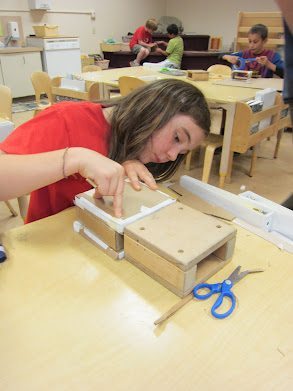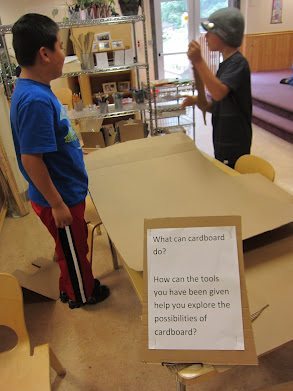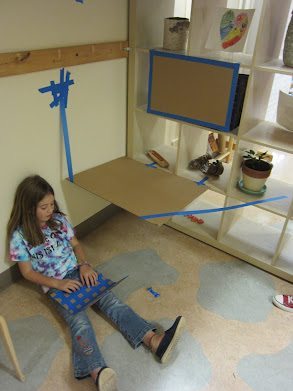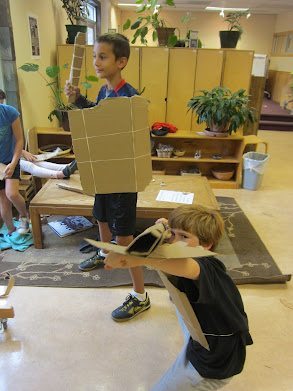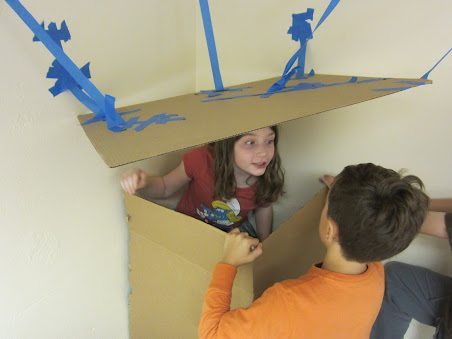Exploring Cardboard, Part 1
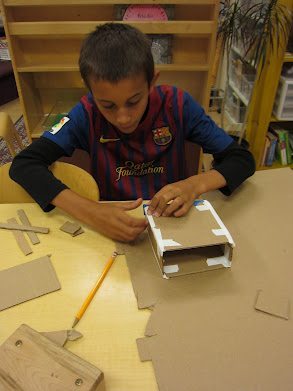
In the second week of school the students in Opal 3 were just beginning to explore how they might make hollow blocks for the youngers students. After spending several days exploring the questions we had about the hollow blocks we decided to make some models of these blocks out of cardboard. We thought that by having the chance to build model blocks using a very forgiving material we would have a better understanding of how to build using wood.
For several days the students played with the material, but with a very direct intention. They were forcused on building an exact replica of one of the wooden hollow blocks. Along the way many questions began to present themselves that spoke directly to their experience with the cardboard itself.
"How can we cut the cardboard so it is straight?"
Student 1: I used the electric scissors, but sometimes they still made the cardboard curvy
Student 2: You should use a ruler and make a straight line. It makes it easier to cut.
"How can I make the carboard thick like the wood on the blocks?"
Some students tackled that challenge by stacking the cardboard while others discovered that you could use less cardboard, which also meant less cutting, by making rectangular prisms instead.
"How exact do I need to be in my measuring?" and "What is the best cutting tool?" were two other questions that needed to be worked through.
With the final goal being an EXACT replica of the cardboard (as opposed to pretty close) this challenge presented many opportunities for students to go back over their work, start over and learn from each other in how best to measure, cut out and arrange their creations.
As individuals and pairs began to finish their models several students took left over pieces of cardboard and began to fashion swords and small knives out of them. I began to wonder how else the kids might be able to explore the possibilities of cardboard. The work on the hollow block models revealed that they enjoyed working with the material and they had come up with a variety of ways to build with it. If left to more open ended exploration how would they approach the material and what might they create?
In the days following the hollow block creation I set up several spaces for them to explore the cardboard. Two questions were posed: "What can cardboard do?" and
"How can the tools you have been given help you explore the possibilities of cardboard?" Small groups of four were given one tools like tape, string, rubber bands, markers or scissors.
"What? how can we make anything without having scissors?" complained many groups. I encouraged them to think about other ways to cut the material as well ask ways to creatively use the items they did have. By setting some limits around the tools and materials they were able to access I was curious to see how inventive they could be and how they might work together in groups to come up with new ways of creating with the cardboard. The groups with string and tape began to explore ways to create structures, while the other groups all began to make swords and shields.
Following the period of investigation the students were eager to play with their creations and we headed outside to see what would unfold. Sword fighting and the defending of cardboard "weapon sheds" became the world into which most of the boys and some of the girls plunged themselves. While the play was important I also didn't want to lose sight of the initial question I had asked, "what can cardboard do?"
While investigating possible ways to explore cardboard I returned to a video I had seen months ago about a 9 year old boy who made an arcade out of cardboard. I wondered if this video might inspire the students in Opal 3 to think more about what cardboard could do. But I also was concerned that by showing the video I might disrupt their creative process and their ability to think about the material in a new way. Would the seeing of Caine's Arcade narrow their vision about how they might use the material? I decided to see what would happen.
When the video ended I asked "What do you think? How can you respond to the story of Caine?"
McCune's hand blasted into the air. "This is so much bigger than just running around with cardboard swords. He got people to come to what he made. He did it all"
Nisa: He was just nine years old and he made a WHOLE arcade!
Micah: He turned something that was not so fun into something that was super fun.
Ocean: And it was for him and for other people.
Nani: And he wanted to share his talents with other people. What is amazing is that he did it all by himself and he did it different.
The video had definitely set the kids to thinking about what was possible. "Do you think you might want to do something like Caine? Do you think you all can be as creative as Caine?" A resounding YES! filled the room. Our next step in the exploration of cardboard was about to begin.


